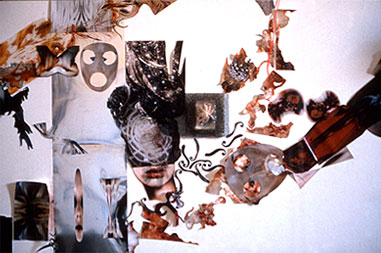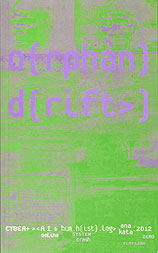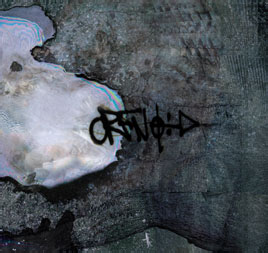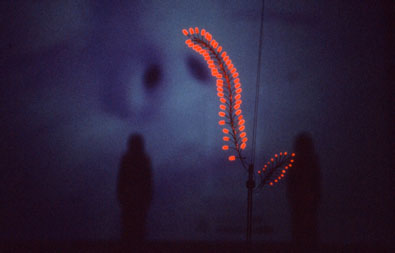0rphan Drift
Between 1994 and 2004 I was part of the collaborative artist 0rphan Drift. It reformed soon after that with myself and Ranu Mukherjee. 0rphan Drift work is currently available on the new archival site, www.orphandriftarchive.com, the original site www.orphandrift.com and on Vimeo and Youtube.
0rphan Drift ARCHIVE
0rphan Drift is a collaborative artist created in London in 1994 by Maggie Roberts, Suzanne Karakashian, Ranu Mukherjee, and Erle Stenberg. For a decade, these core artists collaborated with numerous people on mostly site- specific works. Although it was predominantly made up of visual artists, it also involved sound designers, concept engineers and media activists.
As an artistic entity, 0rphan drift is known for immersive and visually complex works which use the sample and the remix extensively, treating information as matter and the image as a unit of contagion. It produced video and AV performance, collage, text and print works, and published the cyberpunk novel 0(rphan)<d(rift) Cyberpositive. Much of its work explored mimetic patterns of desire, production and consumption- particularly in relation to the rapid technological changes happening at the time- drawing heavily on cyberpunk fiction, polyrhythmic electronica and the underpinnings of African religious systems.
0rphan Drift also functions as an experiment with artistic subjectivity, operating collectively as a singular artist which subsumed the individual artistic identities of its core members. Its mode of production questioned art world conventions around labour and individual authorship as well as object hood, preferring site specific, temporary installation and sometimes performative modes of address - though still rooted in visual aesthetics.
0rphan Drift is cross-contextual and made extensive contributions from 1994 - 2004 in the social arenas around contemporary art, underground music and cyber-feminism/post-structural philosophy. It showed widely including at the Tate Modern, Hayward and Cabinet Galleries in London, contributed cybervisuals to the set of Stephen Speilberg's 'AI' and 'Minority Report' features and Leftfield and NIN world tours and participated in 10 years of international Video art and AV Electronica art events in Norway, Germany, Canada, UK, South Africa and USA.
The archive is an attempt to make some of the works we made between 1994 and 2004 accessible, and to prevent them from disappearing. In doing so we face all of the difficulties of attempting to make an archive of material which involves an untranslatable dimension- the -you had to be there- factor inherent to site specific work ( much of which was poorly documented as a result of our anarchic nature). Although the work was mostly site-specific, it always had an intensely visual and aesthetic dimension to it and a basis in visual object making- making its documentation quite trickster-ish. When you see it, it will appear to be complete, though perhaps missing something which formalizes it. That something is a social context in which its shifting layers of frightening, disturbing, abject, schizophrenic, beautiful, deconstructive, poetic and fragmented frequencies were able to take affect.
Becoming 0rphan Drift
0rphan Drift happened to us in a sense. Individually we did not set out deliberately looking for collaborators or to challenge, so extremely, conventional ways of working. We came together organically, as a response to parts of the art world we found disturbing as much as to recognition of common sensibilities. So, in this early phase we needed to learn to be a collective artist and to publicly state this. The work was a kind of manifesto during this time- and a shedding of habits. We were invited to speak often and began to develop a performative style of presentation which complicated the notion of a 'lecture'. We spent endless hours installing work in galleries, where the painstaking process of installing inadvertently became performative. We found that there was a perceived contradiction between the kinds of critical questions we were asking about production and our lush, excessive (and potentially escapist) visual aesthetic. In underground electronica, where collaboration was more of a rule than an exception, our efforts went into making arresting visual material which could be played live but resisted becoming eye candy or club wallpaper. This period of work was characterized by a distinctly analogue, lo-fi materiality.
0rphan Drift Avatar, Cyberpositive
Once 0rphan Drift had become a singularity, we began to work with avatars and fragmented narratives, as external elements which could guide us in sampling, remixing, collecting and mapping. This immersed intensive phase of 0rphan Drift's production culminated in 1999, in a calendrical project made in collaboration with the Cybernetic Cultural Research Unit based at the time within the Warwick University department of Philosophy.
Syzygy, housed at Beaconsfield Arts, was a series of performances embedded within an installation and framed as an alternative calendar in response to the mythic and looming Y2K. 0rphan Drift became artist, producer, curator and director, organizing components of the project around five avatars as embodiments of different combinations of elemental and technological characteristics. Computers had been integrated into our process by now, and a friction between digital and analogue signal visibly embedded in the work.
0rphan Drift. Cinematic
We began here to replace the sample with the re-make, taking a more cinematic approach to production as well as amplifying our references to cinema as a ubiquitous medium of transmission. In retrospect it could be that we saw cinema changing rapidly and anticipated it becoming nostalgia in the future. We began to remake scenes from films and cut them into remakes of scenes from our own lives, as a way of producing a sense of deja-vu in the viewer, as well as describing the much discussed slippage between fiction and reality, theoretically occurring through extensive exposure to electronic media.
Using the African and Voudou trickster meme, we were tracing the forces that create connections and change, liminal spaces, other worlds - embracing science fiction, inducing effects, spinning forces, complicating the distinctions between material and immaterial phenomenon. Finding seams between zones.
0rphan Drift now
In the early years of the 21st century, the 0rphans began to drift around the globe, resettling in distant lands. 0rphan Drift has recently reformed as a collaboration between Ranu Mukherjee (San Francisco) and Mer (Maggie) Roberts (Capetown and London), with Mike Maurillo making audio for various projects and other occasional named collaborators. We are multi-disciplinary artists, currently focused on making discrete works of art, intentioned for gallery exhibition and consisting of video projection, hybrid collage, painting and installation.
We continue to make science fictional work which is guided by a neo-futurist sensibility and clearly a progression from our earlier work. Our first video work 'Wilderness of Elsewhere's, Colony 1' has been shown in Santiago and San Francisco and we recently produced a series of postcards for Shadowshop; Stephanie Syjuco's parasitic shop at SFMOMA.




